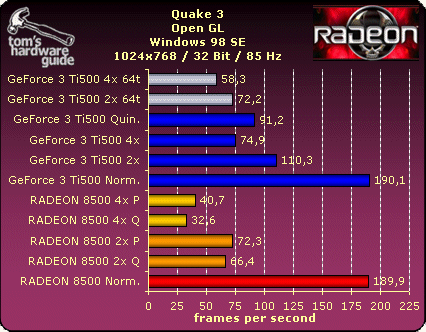RADEON 8500 - Driven To New Heights
Smoothvision, Continued
ATi's SmoothVision is aimed squarely at quality. Apparently (anisotropic) texture-filtering is enabled by default - unlike Nvidia's solution. The ATi driver offers two settings for anisotropic filtering: 'High,' and 'Highest.' (More on that later.) The GeForce3 supports 16tap, 32tap, and even 64tap. Although these settings have theoretically been supported since the 12.xx Nvidia family of drivers, the drivers themselves lack a way to change them. The options can only be set by manually editing the registry, or with the help of freeware tools like NVMax.
Let me repeat: The "GeForce Ti500 - Xx FSAA - 64tap" mode is not available in the standard Nvidia drivers in this form. The reason behind this is unclear, as to why this level of quality is currently unavailable to the Radeon 8500.
Using the standard FSAA settings, the GeForce3 is roughly twice as fast as the Radeon 8500 - but with visibly lower image quality. Yet even with forced 64tap anisotropic filtering the Ti500 can maintain its lead over the R8500 - while offering outstanding image quality. In light of these results, it is unclear why Nvidia isn't officially offering this setting.
At this point, we can conclude that ATi's SmoothVision is slower than Nvidia's FSAA method. The following benchmarks prove that this has nothing to do with filtering.
Get Tom's Hardware's best news and in-depth reviews, straight to your inbox.
